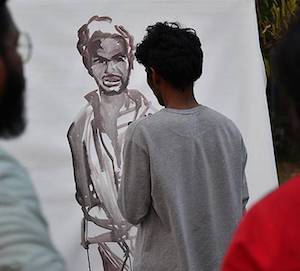Richard Cordaux, Robert Aunger, Gillian Bentley, Ivane Nasidze, S M Sirajuddin, Mark Stoneking
Max Planck Institute for Evolutionary Anthropology, D-04103 Leipzig, Germany.
The origins of the nearly one billion people inhabiting the Indian subcontinent and following the customs of the Hindu caste system are controversial: are they largely derived from Indian local populations (i.e. tribal groups) or from recent immigrants to India? Archaeological and linguistic evidence support the latter hypothesis, whereas recent genetic data seem to favor the former hypothesis. Here, we analyze the most extensive dataset of Indian caste and tribal Y chromosomes to date. We find that caste and tribal groups differ significantly in their haplogroup frequency distributions; caste groups are homogeneous for Y chromosome variation and more closely related to each other and to central Asian groups than to Indian tribal or any other Eurasian groups.
We conclude that paternal lineages of Indian caste groups are primarily descended from Indo-European speakers who migrated from central Asia approximately 3,500 years ago. Conversely, paternal lineages of tribal groups are predominantly derived from the original Indian gene pool. We also provide evidence for bidirectional male gene flow between caste and tribal groups. In comparison, caste and tribal groups are homogeneous with respect to mitochondrial DNA variation, which may reflect the sociocultural characteristics of the Indian caste society.
Source: Papers: tribal
Address : https://lib.bioinfo.pl/find?field=Papers&query=tribal
Date Visited: Sat Jul 16 2011 20:46:40 GMT+0200 (CEST)
BIOINFOBANK INSTITUTE
is a non-for-profit research and development (R&D) organization. Our mission is to create, inspire and incubate innovative ideas in life-sciences. We also promote and facilitate unrestricted and effective research of excellent young Polish scientists. The results of our work are worldwide innovative technological and biomedical solutions. Some of them are converted into commercial projects that can be disseminated across the BioInfoBank network and developed through a spin-off program. The institute is not only involved in research but also initiates the commercial exploitation of scientific discoveries.
Source: BioInfoBank Institute
URL: https://bioinfo.pl
Date visited: 9 February 2020
[Bold typeface added above for emphasis]
Research the above issues with the help of Shodhganga: A reservoir of theses from universities all over India, made available under Open Access >>

“Doctors in the region [Palakkad district] argue that while the proportion of people with mental illnesses is not unusually high, the problem is a crisis because of their socioeconomic vulnerability.” […] “The non-inclusivity of Adivasis is nothing but racial discrimination. Adivasis were always ruled.” | In-depth analysis (Scroll.in 5 April 2023) >>
Learn more
A constitution which guarantees: “The State shall not discriminate against any citizen”
Adivasi (Adibasi) | Usage in legal and historical records, in textbooks, scholarly papers and the media – Classifications in different states
Adivasis in India’s Freedom struggle
Ambedkar was more than the drafter of the Constitution
Colonial policies | Freedom Struggle | Independence
Constitution and Supreme Court
eBook | Background guide for education
eBook | “Where the mind is without fear”: Tagore, Gitanjali and the Nobel Prize
Education and literacy | Right to education
History | Struggle for India’s freedom | Time now to undo the historical injustice
Misconceptions | “Casteism” and its effect on tribal communities
Explore India’s tribal cultural heritage with the help of several interactive maps, specially created for visitors to this website:
- An alphabetical journey across India: from Andaman to West Bengal
- Northeastern India: the “Seven Sister States” & Sikkim
- Visit a museum in India: Indigenous art, anthropological & ethnographical collections
- A virtual journey across time and space: from Gondi-Harappan to present & future
- Locations for video documentaries & external media contents
- Particularly Vulnerable Tribal Groups & Endangered languages
- Places associated with press reports and blogs about India’s tribal cultural heritage
- A virtual journey across India: from Ladakh to Gujarat